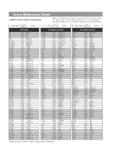Transcription of Cross-Validation - Lei Tang
1 Comp. by: BVijayalakshmiGalleys0000875816 Date:6/11/08 Time:19:52:53 Stage:First Proof File Path://ppdys1108/Womat3/Production/PRODE NV/0000000005/0000008302/0000000016/. Proof by: QC by: C. be available for each algorithm. Different methodolo- Cross-Validation gies such as averaging can be used to obtain an aggre- gate measure from these sample, or these samples can PAYAM R EFAEILZADEH , L EI TANG , H UAN L IU be used in a statistical hypothesis test to show that Arizona State University one algorithm is superior to another. Synonyms Historical Background Rotation estimation In statistics or data mining, a typical task is to learn a model from available data. Such a model may be a regression model or a classifier. The problem with eval- Definition uating such a model is that it may demonstrate adequate Cross-Validation is a statistical method of evaluating prediction capability on the training data, but might and comparing learning algorithms by dividing data fail to predict future unseen data.
2 Cross-Validation is a into two segments: one used to learn or train a model procedure for estimating the generalization performance and the other used to validate the model. In typical in this context. The idea for Cross-Validation originated Cross-Validation , the training and validation sets must in the 1930s [6]. In the paper one sample is used for cross -over in successive rounds such that each data regression and a second for prediction. Mosteller and point has a chance of being validated against. The basic Turkey [9], and various other people further developed form of Cross-Validation is k-fold Cross-Validation . the idea. A clear statement of Cross-Validation , which is Other forms of Cross-Validation are special cases of similar to current version of k-fold Cross-Validation , k-fold Cross-Validation or involve repeated rounds first appeared in [8].
3 In 1970s, both Stone [12] and of k-fold Cross-Validation . Geisser [4] employed Cross-Validation as means for In k-fold Cross-Validation the data is first parti- choosing proper model parameters, as opposed to tioned into k equally (or nearly equally) sized segments using Cross-Validation purely for estimating model per- or folds. Subsequently k iterations of training and vali- formance. Currently, Cross-Validation is widely accepted dation are performed such that within each iteration a in data mining and machine learning community, and different fold of the data is held-out for validation serves as a standard procedure for performance estima- while the remaining k 1 folds are used for learning. tion and model selection. Fig.
4 1 demonstrates an example with k = 3. The darker section of the data are used for training while the Scientific Fundamentals lighter sections are used for validation . In data mining There are two possible goals in Cross-Validation : and machine learning 10-fold Cross-Validation (k = 10). To estimate performance of the learned model from is the most common. available data using one algorithm. In other words, Cross-Validation is used to evaluate or compare to gauge the generalizability of an algorithm. learning algorithms as follows: in each iteration, one or To compare the performance of two or more dif- more learning algorithms use k 1 folds of data to learn ferent algorithms and find out the best algorithm one or more models, and subsequently the learned for the available data, or alternatively to compare models are asked to make predictions about the data the performance of two or more variants of a para- in the validation fold.
5 The performance of each learning meterized model. algorithm on each fold can be tracked using some pre- determined performance metric like accuracy. Upon The above two goals are highly related, since the sec- completion, k samples of the performance metric will ond goal is automatically achieved if one knows the Comp. by: BVijayalakshmiGalleys0000875816 Date:6/11/08 Time:19:52:53 Stage:First Proof File Path://ppdys1108/Womat3/Production/PRODE NV/0000000005/0000008302/0000000016/. Proof by: QC by: 2 C Cross-Validation Cross-Validation . Figure 1. Procedure of three-fold Cross-Validation . accurate estimates of performance. Given a sample and this can skew the results. Furthermore, the data in of N data instances and a learning algorithm A, the the test set may be valuable for training and if it is held- average cross -validated accuracy of A on these N out prediction performance may suffer, again leading instances may be taken as an estimate for the accuracy to skewed results.
6 These problems can be partially of A on unseen data when A is trained on all N addressed by repeating hold-out validation multiple instances. Alternatively if the end goal is to compare times and averaging the results, but unless this repeti- two learning algorithms, the performance samples tion is performed in a systematic manner, some data obtained through Cross-Validation can be used to per- may be included in the test set multiple times while form two-sample statistical hypothesis tests, compar- others are not included at all, or conversely some data ing a pair of learning algorithms. may always fall in the test set and never get a chance to Concerning these two goals, various procedures are contribute to the learning phase.
7 To deal with these proposed: challenges and utilize the available data to the max, k-fold Cross-Validation is used. Resubstitution validation In resubstitution validation , the model is learned from K-Fold Cross-Validation all the available data and then tested on the same set of In k-fold Cross-Validation the data is first partitioned data. This validation process uses all the available data into k equally (or nearly equally) sized segments or but suffers seriously from over-fitting. That is, the folds. Subsequently k iterations of training and valida- algorithm might perform well on the available data tion are performed such that within each iteration a yet poorly on future unseen test data. different fold of the data is held-out for validation while the remaining k 1 folds are used for learning.
8 Hold-Out validation Data is commonly stratified prior to being split into k To avoid over-fitting, an independent test set is pre- folds. Stratification is the process of rearranging the ferred. A natural approach is to split the available data data as to ensure each fold is a good representative of into two non-overlapped parts: one for training and the whole. For example in a binary classification prob- the other for testing. The test data is held out and not lem where each class comprises 50% of the data, it is looked at during training. Hold-out validation avoids best to arrange the data such that in every fold, each the overlap between training data and test data, yield- class comprises around half the instances. ing a more accurate estimate for the generalization performance of the algorithm.
9 The downside is that Leave-One-Out Cross-Validation this procedure does not use all the available data and Leave-one-out Cross-Validation (LOOCV) is a special the results are highly dependent on the choice for the case of k-fold Cross-Validation where k equals the training/test split. The instances chosen for inclusion number of instances in the data. In other words in in the test set may be too easy or too difficult to classify each iteration nearly all the data except for a single Comp. by: BVijayalakshmiGalleys0000875816 Date:6/11/08 Time:19:52:57 Stage:First Proof File Path://ppdys1108/Womat3/Production/PRODE NV/0000000005/0000008302/0000000016/. Proof by: QC by: Cross-Validation C 3. observation are used for training and the model is Bouckaert [1] also studies the problem of inflated tested on that single observation.
10 An accuracy estimate type-I error with 10-fold Cross-Validation and argues obtained using LOOCV is known to be almost unbi- that since the samples are dependent (because the ased but it has high variance, leading to unreliable training sets overlap), the actual degrees of freedom is estimates [3]. It is still widely used when the available much lower than theoretically expected. This study data are very rare, especially in bioinformatics where compared a large number of hypothesis schemes, and only dozens of data samples are available. recommend 10 10 fold Cross-Validation to obtain 100 samples, followed with t-test with degree of free- Repeated K-Fold Cross-Validation dom equal to 10 (instead of 99). However this method To obtain reliable performance estimation or compar- has not been widely adopted in data mining field either ison, large number of estimates are always preferred.





